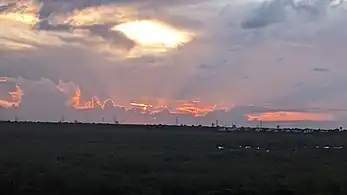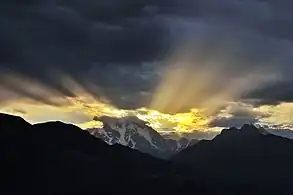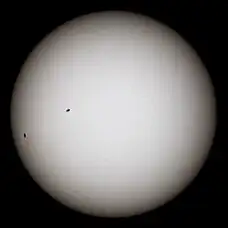Crepuscular rays are sunbeams that originate when the Sun is just above or below a layer of clouds, during the twilight period.[1] Crepuscular rays are noticeable when the contrast between light and dark is most obvious. Crepuscular comes from the Latin word crepusculum, meaning "twilight".[2] Crepuscular rays usually appear orange because the path through the atmosphere at sunrise and sunset passes through up to 40 times as much air as rays from a high Sun at midday. Particles in the air scatter short-wavelength light (blue and green) through Rayleigh scattering much more strongly than longer-wavelength yellow and red light.
Loosely, the term crepuscular rays is sometimes extended to the general phenomenon of rays of sunlight that appear to converge at a point in the sky, irrespective of time of day.[3][4]
A rare related phenomena are anticrepuscular rays which can appear at the same time (and coloration) as crepuscular rays but in the opposite direction of the setting sun (east rather than west).
Gallery
 Crepuscular rays as seen from Puerto Morelos, Mexico (October 2022)
Crepuscular rays as seen from Puerto Morelos, Mexico (October 2022) Crepuscular rays in Hunza Valley, Pakistan
Crepuscular rays in Hunza Valley, Pakistan Orbital view of crepuscular rays
Orbital view of crepuscular rays Sunset at Heron Island, Queensland, Australia (April 2023)
Sunset at Heron Island, Queensland, Australia (April 2023).jpg.webp) Crepuscular rays before sunset, Tikveš
Crepuscular rays before sunset, Tikveš
See also
- Earth's shadow – Shadow that Earth itself casts through its atmosphere and into outer space
- Foreglow – Whitish or rosy light during twilight or after sunset
References
- ↑ Naylor, John (2002). Out of the Blue: A 24-Hour Skywatcher's Guide. Cambridge University Press. pp. 77–79. ISBN 9780521809252.
- ↑ Edens, Harald. "Crepuscular rays". weatherscapes.com. Retrieved 2011-11-01.
- ↑ "Crepuscular Rays".
- ↑ "Weather Facts: Crepuscular rays | weatheronline.co.uk".
External links
![]() Media related to Crepuscular rays at Wikimedia Commons
Media related to Crepuscular rays at Wikimedia Commons

